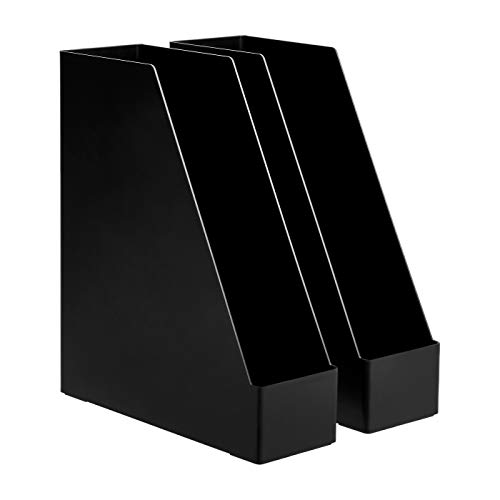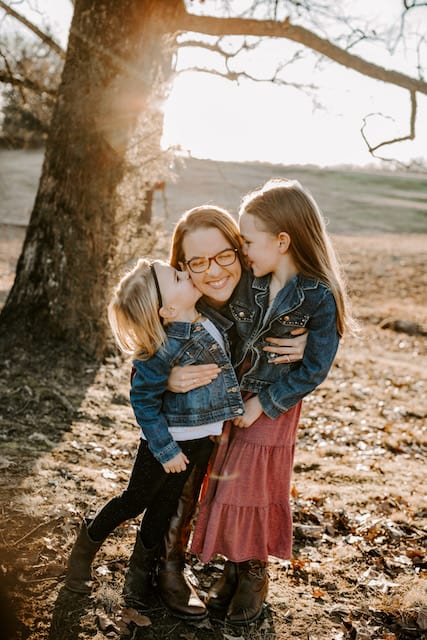Do you find yourself in the midst of STUFF and need some help to get it all in order? Not everyone has a gift for homeschooling organization and even if you do, sometimes things get out of hand. If you need some ideas and a little kick in the pants to get your homeschool books and supplies organized then you’re in the right place.
Keep reading to get 11 homeschooling organization tips for the unorganized.
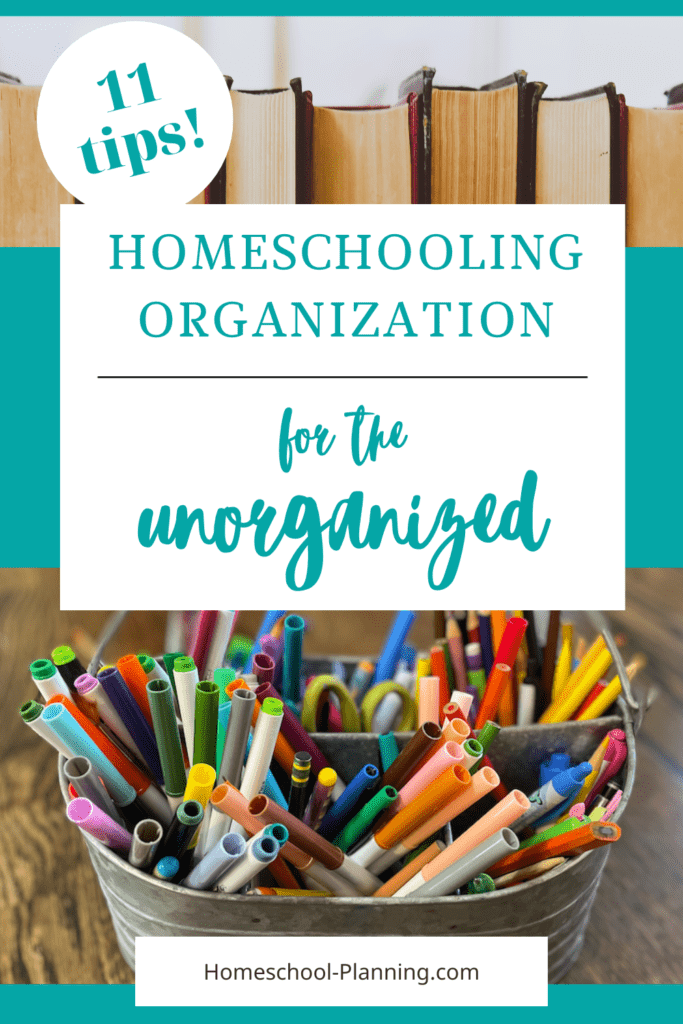
*Note: This post contains affiliate links, which means I receive a small commission, at no extra cost to you, if you make a purchase using the link. Please see my disclosure for more details.
1. Keep it nearby
Wherever it may be you do school in your house, it’s helpful to keep your homeschool supplies nearby. You may have a school room you use for school, and in that case homeschooling storage is pretty straightforward. All your homeschool supplies can be right there.
But many homeschoolers don’t have a dedicated area and have free range of the house. If you do school in the living room, keep your books there on a shelf. If your kids do school in their own rooms, they can keep their books there. Read aloud books can easily be kept on a rolling cart to move wherever the reading takes you.
There’s no reason to have to trek through the house with a pile of books. Or walk back to the school room when you forgot an eraser. Make it easy on yourself and store your supplies nearby where you actually do school.
2. Give each person a space
A simple way to keep things organized in your homeschool is to give each person a space. This may be their own cubby in a shelving system or a special basket just for them. You may use drawers where each child gets their own or a certain space at the table. However you organize homeschool materials, individual space can bring tidiness.
Each child can have their space for their textbooks, workbooks, notebooks, binders, manipulatives, and whatever else they use regularly. Even toddlers and preschoolers can have their own space for toys they use only at school time. This is an idea to make each child to feel special and included.
I also make a space for my things in an area. Teacher’s materials and answer keys can find their own space together.
The resources we use together, like for morning time, can also be organized in the same space.
When each person has their own space, it can also help with cleaning up at the end of the day. Children can take ownership of their space. It will help them to know where anything that is theirs belongs.
3. Only keep what you use
It’s so easy to collect homeschool curriculum – we all know it’s valuable. But if you aren’t using it, there’s no reason to hang on to it. Get it out of your space. It’s now clutter. If you know you’ll need it again in the future, move it to your longer term storage area and away from your everyday books.
The trick is to remember that next time you see an amazing deal on homeschool curriculum you don’t have to buy it! Don’t bring in more things you won’t use. Let someone else get an amazing deal on something they will use.
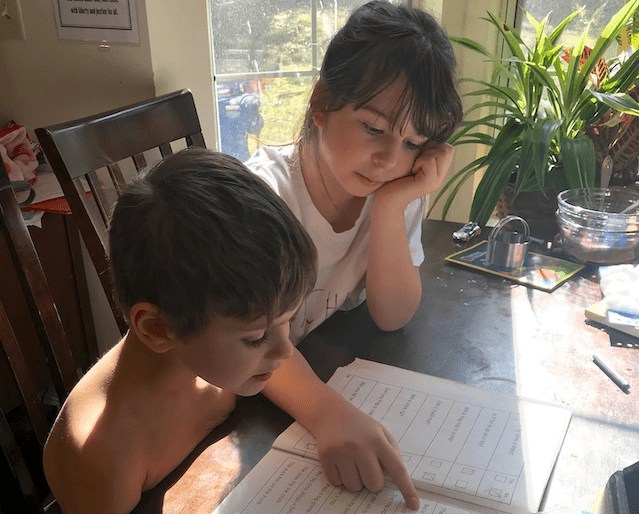
4. You don’t need a big space
It’s tempting to design a beautiful area in your home for homeschooling. Get the cute desks, beautiful posters, and fancy curriculum. But you don’t really need a big or fancy space. All you really need to homeschool is a love for your kids and a library card. That doesn’t take much space.
Of course, most of us have more than that. The fact remains that a dedicated homeschool area is not required to have a successful homeschool. One small closet or a couple shelves may be all you need to have an organized homeschool for a small space. Sometimes less is more.
I know my kids often end up doing schoolwork on the couch in our house. Though we do often use the dining room table as well. The point I’m trying to get at is that you shouldn’t feel obligated to fill a room with tons of homeschool materials.
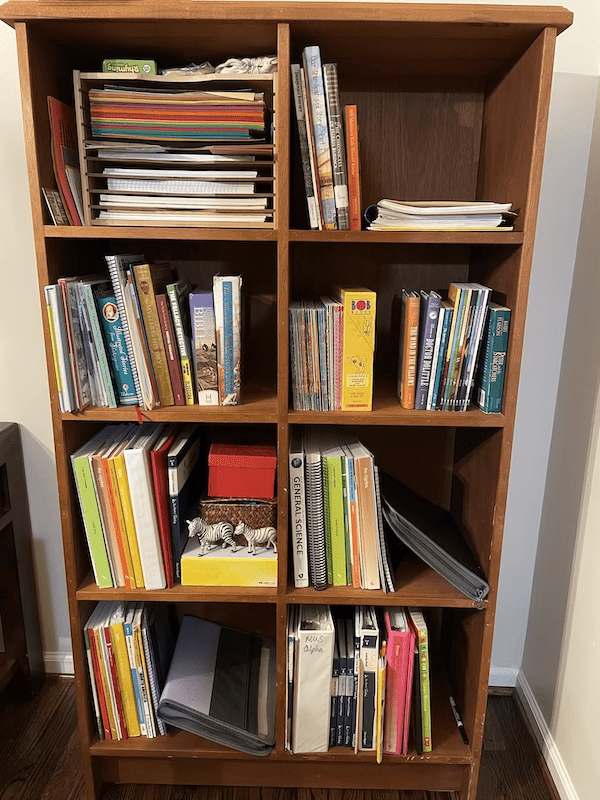
5. Go back to the basic supplies
If your house is being overtaken with homeschool stuff and you feel like you need more space, maybe you really just need to pare down on what you have. Go back to the basic supplies for homeschooling and see how much more organized you feel.
Keeping a back stock of all the potential science and art supplies may seem great but if you never use them, they are just taking up space.
A simple homeschool curriculum, some basic school supplies, and a library card. Even just these things can take up a good amount of space, so keep it simple.
Must-haves for a homeschool room
What are the must-haves for a homeschool room, you may ask? Your list might differ, but here is a good starting point:
- Workbooks
- Teacher books
- Readers
- Educational toys/games
- Science equipment and supplies
- Paper of all kinds
- Math manipulatives
- Library books
- Printer
- Table or desks
- Comfy chairs
- Book storage
- Supply storage
- A good planner
- Pencil/Pens
- Markers
- Crayons
- Colored Pencils
- Scissors
- Tape
- Glue (sticks)
- Stapler
- Erasers
- Ruler
- Hole punch
- Paints/paint brushes
- Decor (optional)
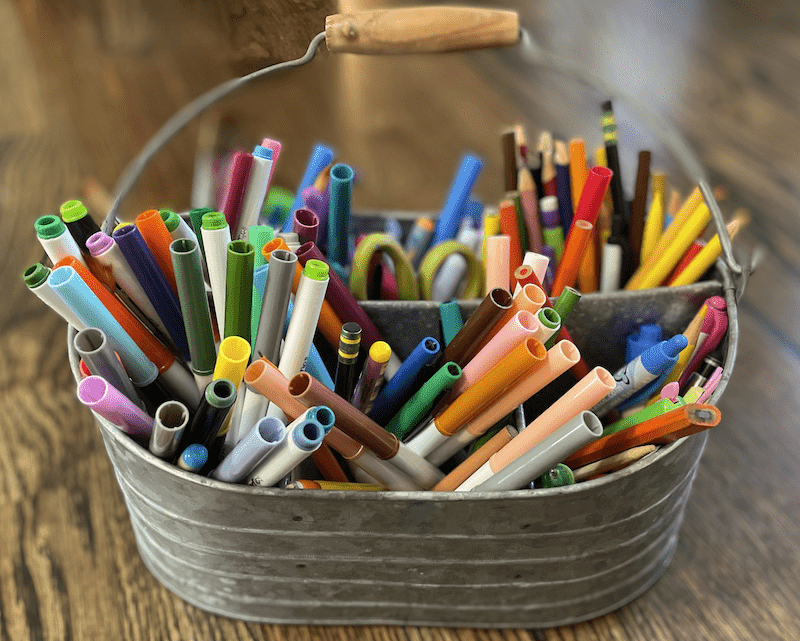
6. Find a place for everything
One of the big reasons my house becomes cluttered is when items don’t have a good spot to belong. So when working on homeschool organization, you should be sure to find a place for everything.
This can be overwhelming if you have a lot of stuff. So I like to start by removing all that doesn’t belong in the space right now. Take out everything you’re not using. Then decide how to organize what you do have.
Don’t forget to also organize papers that have been completed. You need to find a place for samples of the kids’ work to keep. Some set all work aside during the year then sort it all at the end of the year. Others organize immediately through the year into a binder for each child. Either way, make a space for that as well as papers that are waiting for you to look over them.
Some great tools to use are shelves, cubbies, baskets, drawer systems, buckets, desk organizers, and shelf organizers. Here are some examples.
7. Organize by category
Many organize their books and supplies by category. This can be a simple way to know where things are and where they should be put away. All the teacher books together, art supplies in one space, science stuff on a shelf, morning time books in a basket. You get the idea.
Here are some categories you may want to use when organizing homeschool supplies:
- Teacher books
- Answer keys
- Student books
- Science supplies
- Art supplies
- Flashcards
- Manipulatives
- Library books
- Reading together
- Morning Time
- Free reading
- Assigned reading
- Reference books
- Games
- Toys
- Writing utensils
- Adhesives (glue and tape)
- Paper
- Individual students
- Supplemental books
- Finished school work
- To be graded/looked over
- Extra notebooks
- Worksheets/printables
- Activity books
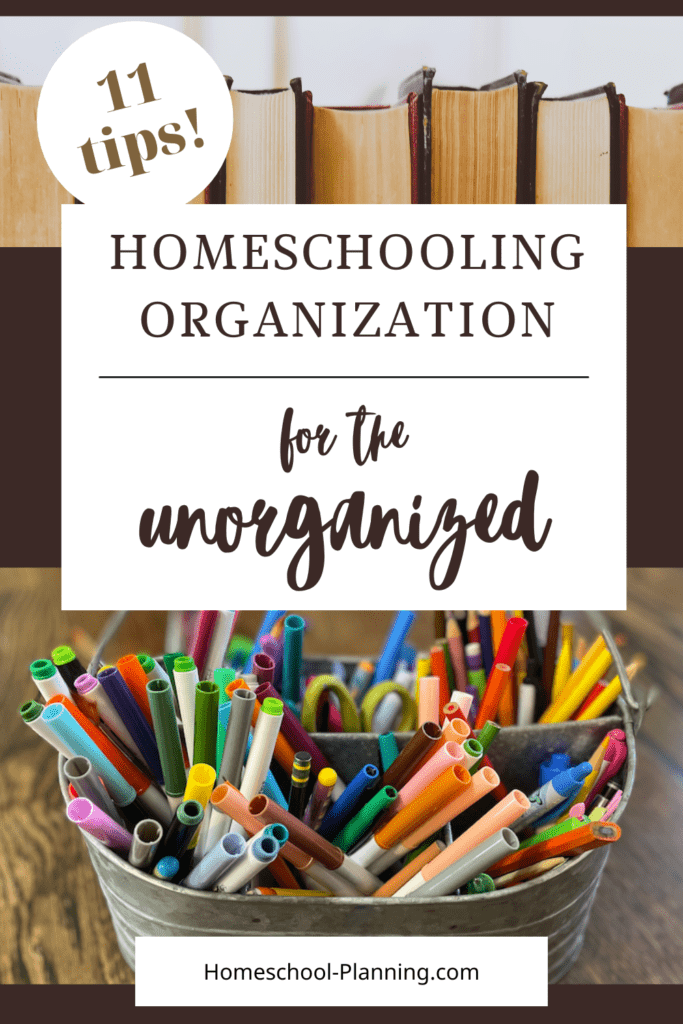
8. Organize by time
Another way to organize books and supplies is by how often they are used. It’s helpful to put all the books and resources you use every day in one area. But putting those that you use only occasionally can fill up space that may be needed. So keeping those in a separate section may be helpful.
Items you aren’t using this year at all could be stored in a completely different area. A basement, attic or tucked away closet could work. There’s no need for these items to be cluttering up your usable space. This would be things you may be using for another child or are planning on using in the future but haven’t reached that level yet.
Here some ideas for organizing your resources by time:
- Use daily
- Use often
- Use weekly/monthly
- Use rarely but need accessible
- Use later in the year
- Use in the future (consider storing)
I will often organize our things by both category and then by time. For instance, we have many books we use for school. I have them divided generally by categories like student, teacher, morning time, library, and other.
Within those sections I have also moved the items we use daily together and those we use less regularly in another section. Books we will use later this year are stored in another section. They’re all close together, so as we go through the year I can move them around as needed.

9. Use a planner
A planner is the only way to organize all the thoughts in your head. You can organize your physical stuff all day long and never feel organized because your mind is still a mess. A planner doesn’t have to be complicated. Actually a simple planner is better.
You may say you’re not a planner or planners never work for you. Well I say you haven’t learned how to use a planner in a way that helps you. But it’s not the planner that helps – it’s not magical. It’s the process of getting your thoughts out of your head and organized in a usable way.
This is why there are millions of planners out there – because we all process our thoughts differently. And different times in our lives we need different things as well. So if you want to be more effective in your homeschooling life, find a planning system that works for you and get your brain a little more organized.
To get you started, I’ve created some free homeschool planning pages to help you organize your homeschool. Download those now.

For suggestions on the best homeschool planners out there, read about those at the following links:
10. Have a plan
If you have any goals in life (and I hope you do!), you need a plan to get there. You may not always write it down. It may not be detailed. But having a plan will help you get where you are wanting to go in life.
Homeschooling your children requires some sort of general goals and plans. They may be basic, like finishing a certain curriculum or they may be more open-ended like enjoying nature together. To do those things, you have laid out in your mind how to make those things happen, and that’s your plan.
Don’t let that scare you. Plans are good. It doesn’t mean you’re all of a sudden planner obsessed and Type A.
But I do encourage you to work on those plans in your head, and maybe even write them down. Work out the big steps it will take to get you to your goals, to get through the curriculum, to answer the questions in your head.
Be a little proactive in your life and make some plans to frame your week and your day. Teach your children that goals and plans are good and write them down. It will help you make them happen. But don’t worry, plans can be changed.
We’re not going for perfection, just functionality.
For some help on planing out your homeschool year, check out my posts. These will help you organize all the way from goal setting, to finding curriculum, to records and supplies. You can start by making a good homeschool plan with this post. Or if you really want to dive in, get all my homeschool planning advice in this post.
How to Create a Homeschool Plan that Works for You
11. Put it back
Once you get your homeschool organized, its tragic for it all to become a mess again. And it will if things aren’t put away after they’re used. So make it a habit for yourself. Encourage your kids to do the same.
If everything has a place, putting things back in their places should not be difficult. But staying on top of it is the key. Once you get loose about putting things away, they will pile up and get overwhelming again.
A great way to make this happen is to set up a short cleaning time every day. It could be in the afternoon, before bed, or whenever time works for you. Set a timer for 10-15 minutes and everyone can work together to clean up. Most of this cleaning will likely just be putting things away.
It’s amazing how much a difference it makes.
Closing
There are many ways to organize homeschool books in your house, depending on your available space and preferences. Go back to old skills of sorting and find a place for every item. Make the most of the space you have and make it yours. Ultimately what matters in homeschooling organization is that the system you set up works for you and your family and is easy to maintain. The goal is not perfection but to create a functional and comfortable space for you and your family. You’ve got this!
Related post
Organize homeschool supplies from start to finish
Managing housework and homeschooling












